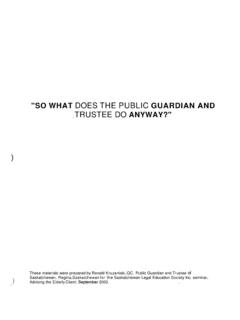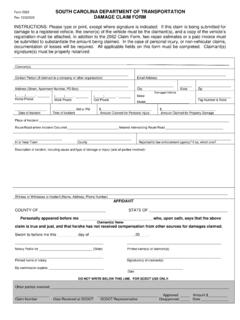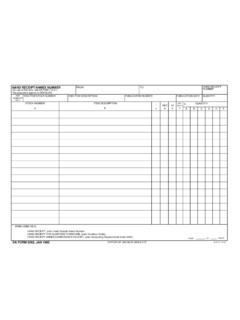Transcription of THE STEP-WISEINTERVIEW
1 THE step - wise interview . A PROTOCOL FOR INTERVIEWING CHILDREN. JOHN C. YUILLE. Overview 1. The step wise interview has been designed with three distinct goals in mind: 1. To minimize any trauma the child may experience during the inten'iew. 2. To maximize the amount and quality of the information obtained from the child while, at the same time, minimizing any contamination of that information. 3. To maintain the integrity of the investigative process for the agencies invohred. 2. The step wise interview is an investigative interview . The procedure encourages and facilitates the child's recall of events.
2 Every opportunity is provided to obtain the child's version. This is done by always beginning with the most general, open phase of the interview , and proceeding to more narrow forms of questioning only when required. The less prompting the better. The interviewer must demonstrate PATIENCE and allow as much of the interview content as possible to come from the child. ). 3. The step - wise interview is part of the fact finding process. If the investigator entertains only a single hypothesis, there exists a chance that the iD\'estigation might turn into an effort to 'prove' that hypothesis rather than an effort to find the hypothesis that best matches the facts of the case.
3 Not only is this a poor investigative technique ( working against goal no. 2) but it goes against the best interests of the child ( working against goal no. 1) if that h)'pothesis is not the correct one. It is important that the investigators generate several h)'potheses about the case. 4. The inten'iewer must be alert to developmental differences in language and memory. Never assume that you know what a child means by the use of a particular word. Always ask if the meaning is not obvious. Similarly, make certain that you are employing words and concepts which the child understands.
4 General Considerations When Interviewing Children a. LOCATION. 1. If circumstances permit, the interview should be conducted in a room specifically designed for the purpose. The interview room should be quiet and as free as possible from distractions. This includes distractions from outside the room ( noise, people attempting to enter the room, telephones and so on.) and from within the room ( toys, wheeled furniture, interview aids, etc.). The interview room should be as comfortable as possible with a range of sizes of furniture so that both preschoolers and adolescents can be reasonably accommodated.
5 2. Built-in audio and video taping capabilities are an advantage of a dedicated interview room. Whether the taping equipment is visible or not, it is 2. essential that the interviewer acknowledge the presence of the equipment. The purpose of the equipment sbould be explained to tbe cbild. 3. If the interview room is contained within an official context ( , a police office), every effort should be made to provide a separate entrance and waiting area. 4. If the interview cannot be conducted in a specially designed room, arrange tbe room to conform as closely as possible to this protocol.
6 It is not advisable to conduct the inten'iew in tbe location in whicb the abuse occurred. b. PARTICIPANTS. 1. Inter-agency co-operation often requires that both a social worker and a police officer are present for the interview . In such cases, they must arrange, in advance, who will initially conduct the interview . The other person tben takes the role of the recorder. Altbough the recorder introduces bimselflherself at tbe start of tbe interview and responds, when appropriate, to the child, the recorder does no(. actively participate in the interview . The reason for this is tbat baving two active interviewers can be confusing for a child.)
7 Instead, the recorder takes notes. If at any time the inten'iewer is baving difficulty, tbe interviewer and tbe recorder can exchange roles. If the interviewer does not encounter any difficulties, tbe two workers will still exchange roles after the interviewer bas exbausted hislher questions. 2. A parent, guardian, tberapist, or otber concerned adult sbould not be present during the interview . The concerned adult could watch tbe interview tbrough a one way mirror or on a video monitor, if either is available, or later view tbe video tape of the interview . Be sure tbat some support is provided to the parent(s) who is observing the inten'iew.
8 Tbe exception to this exclusion of other adults occurs when the child will not consent to being interviewed without the presence of a parent or other trusted adult. In this case every effort must be made 3. to impress on the adult the importance of not interfering in the interview . They should be asked to remain silent and not to participate in any way (unless instructed to do so). If at all possible, they should be seated out of the child's line of vision and not have any physical contact with the child during the interview . In addition, they should be cautioned about how easy it is to react, without necessarily being aware of doing so, to the topics being raised and how such reactions can potentially contaminate the child's account.
9 3. The interviewer and recorder should sit close to the child at a distance that is comfortable for everyone. Make sure that there are no objects ( , tables). between the inten'iewer and the child, although a table next to both of you may be useful. With younger children it may be preferable for everyone to sit on the floor. c. RECORDING. 1. The interview should be video taped. The video picture should be focused upon the child but also include the interviewer and recorder. An audio tape backup is very useful, for both safety's sake (equipment has been known to malfunction). and for making transcripts.
10 2. In the absence of video equipment an audio tape should be made. If audio taping is also not possible a verbatim written record should be kept by the recorder. 3. Continuity of the video and/or audio recording is important. Begin any tape with a statement of who is present, and when and where the interview is occurring. Any interruption in the recording should be explained on the tape. A. policy for the storage of and access to these tapes should be carefully developed. d. PREPARATION. 1. There are many situations in which it is useful to interview a child's parent before the interview with the child.









